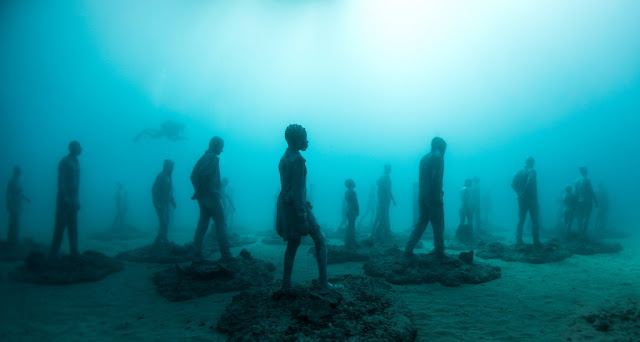Here are two examples of environmental art that might help us think through affect and the Anthropocene.
(1) Wrapped Coast by Christo & Jeanne-Claude
This work provides me with another way of seeing the coast. The morphing shape of the coastline helps me to think through the concept of the 'the fold' or 'folding', and I ask myself whether this enveloping substance laid upon the rocks might help me think with the concepts of 'de-territorialization' & 're-territorialization'?
Here we see an example of art engaging with the anthropocene; artists wrap and affect the texture of the land.
I'd like to keep interpretation open here, but I'm immediately struck by the dissonance of wrapping the coast. From my position in 2016 I can't help but see this ephemeral gesture in relation to climate change. Like a child I imagine, if only, we could protect the shoreline in this way, by wrapping it up, placing a silky bandage over it for safe keeping.
 |
| Wrapped Coast, One Million Square Feet, Little Bay, Sydney, Australia, 1968-69 Photo by Harry Shunk |
 |
| Wrapped Coast - One Million Square Feet, Little Bay, Sydney, Australia (1968 - 69). Photo by Harry Shunk |
 |
Christo and Jeanne-Claude Wrapped Coast, One Million Square Feet, Little Bay, Sydney, Australia, 1968-69
Photo by Harry Shunk © 1969 Christo
|
(2) Museo Atlantico by underwater sculptor James deCaires Taylor
According to deCaires, “The work is not intended as a tribute or memorial to the many lives lost but as a stark reminder of the collective responsibility of our now global community”. Furthermore the museum "is designed on a conservational level to create a large scale artificial reef to aggregate local fish species and increase marine biomass whilst, on the other hand, to raise awareness to current threats facing the worlds oceans. The main installation, The Rubicon features a group of 35 people walking towards a gate, a point of no return or a portal to another world."
 |
| James deCaires Taylor's underwater exhibit "Rubicon" makes up part of the Museo Atlantico installed in the waters of Lanzarote, on of The Canary Islands. Photo by Jason deCaires Taylor |
 |
| "The Raft of the Lampedusa" Photo by Jason deCaires Taylor |
For more info see: PBS Article on "Europe's First Underwater Museum Offers A Stark Reminder Of The Refugee Crisis" & deCaires' Website
* Whereas Christo and Jeanne-Claude resisted political messages, the Museo Atlantico is an example of a contemporary artist engaging directly with environmental themes and global crisis. While Christo and Jeanne-Claude's installations were a blip in time, deCaires intends his underwater sculptures to last, and encourage life to grow around.
Thanks for sharing! The Museo Atlantico work reminds me of one the new acquisitions at the AGO, Infestation Piece: Musseled Moore by Simon Starling. For the Infestation Series, Starling crafted several steel sculptures and deposited them in the ocean to alter according to the underwater ecology. Once harvested for display, this work has raised many questions about conservation because the salt water decolourations and mussel growth is as much a part of the work as Starling's steelcraft. It's as if the piece is a collaboration between Starling and the ocean itself.
ReplyDeleteSee image here: http://www.ago.net/assets/images/555/Starling-Moore_660px.jpg